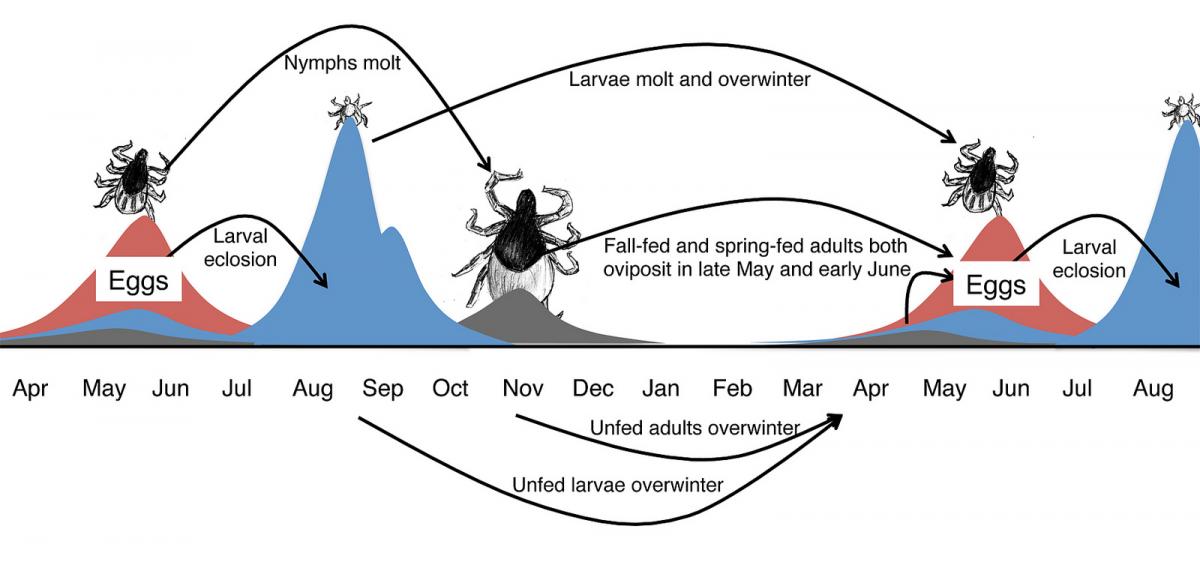
CORVALLIS, Ore. - A new study suggests that changing climate patterns may be altering the life cycles of blacklegged ticks in the northeastern United States, which could increase transmission among animals - and ultimately humans - of certain pathogens, including the bacterium that causes Lyme disease.
Other colder regions of the country that have sufficient populations of blacklegged ticks - particularly Wisconsin and Minnesota - may also experience a higher risk of Lyme disease. However, the changing life cycles of the ticks may result in a less-likely probability of transmitting a more deadly pathogen that results in Powassan encephalitis, the researchers say.
Results of the research are being published this week in a special issue of Philosophical Transactions of the Royal Society B dedicated to climate change and vector-borne diseases.
A team of scientists led by Taal Levi of Oregon State University and Richard Ostfeld of the Cary Institute of Ecosystem Studies analyzed 19 years of data on blacklegged ticks in the Northeast and their relationship to "host" animals ranging from small rodents to deer and other larger mammals. They then overlaid the results with climate data and used computer models to predict what may happen in the future.
"The bottom line is that as the climate warms, it is pushing the timing of tick nymphs and larvae forward, potentially changing the interactions they have with their hosts," said Levi, an assistant professor in OSU's Department of Fisheries and Wildlife in the College of Agricultural Sciences and lead author on the study.
"October is a key month," he added, "because the difference between a cold fall and a warmer fall can have a profound effect on when the ticks interact with their hosts."
Blacklegged ticks can be found in hardwood forests all along the eastern seaboard as well as in the northern states. They have a two-year life cycle that goes from eggs, to larva, to nymphs to adults.
After adult ticks lay eggs in the spring, the larvae emerge in the summer and in August and September they begin looking for a host to feed upon - usually mice, voles and other small rodents. They are not born infected with pathogens, but can become infected after feeding upon an infected host. However, their feeding lasts only a few days and they then become inactive and thus are not a threat to humans or large mammals at this stage.
As they transform to nymphs, they become active the following spring when they begin looking for a host. If not previously infected as larva, they can become infected again by selecting a host carrying a pathogen. Studies have shown that as many as one out of four blacklegged tick nymphs carry the Lyme disease bacterium.
"This is where climate change comes in," Levi said. "When nymphs emerge months before larvae, they inoculate the host community with pathogens that the later-emerging larvae can then contract. The Lyme disease pathogen is long-lived - it will remain in the host. So an increasing gap between the nymphs feeding in the spring and the next cohort of larvae feeding in late summer will give the nymphs more time to infect the hosts with bacterium that can then be passed to the next generation of tick larvae."
Since ticks can't fly or jump, they usually find hosts by hanging onto the ends of grass blades or small branches and attaching themselves to animals. This hit-or-miss approach results in some tick larvae that don't find a host. And if the weather is cold and activity ceases early, the number of larva that "over-winter" increases.
When that happens, the larva and nymphs are more likely to feed at the same time, the researchers say, and that may increase the chance of transmitting the pathogen causing Powassan encephalitis, which can be deadly but is very short-lived in hosts. The disease causes mortality in about 10 percent of human patients, and persistent illness in another 50 percent.
"Luckily the pathogen for Powassan doesn't persist for very long, but having synchronous activity between larva and nymphs makes transmission more likely," Levi said. "If autumn temperatures increase, it looks like fewer larvae will overwinter to feed at the same time as nymphs, which should reduce the risk of Powassan virus."
It is the nymph stage that is most problematic for humans, the researchers say. The larva usually target rodents, which are low to the ground and plentiful. Adult ticks can easily transmit the Lyme disease pathogen, but adult males do not feed and females usually target deer and other woodland creatures. Also, it takes three days for Lyme disease to establish after a tick bite and most people will spot and remove the tick within that time.
Powassan transmission, however, is almost immediate - hence the concern for colder climate states.
Blacklegged ticks also inhabit the western United States, though in much fewer numbers. Tick transmission of Lyme disease has grown rapidly in the Northeast, however, with estimates of 200,000 cases per year in New York alone.
The study was supported by the National Science Foundation, National Institutes of Health, Environmental Protection Agency and Dutchess County, N.Y. Other researchers on the study include Felicia Keesing of Bard College; and Kelly Oggenfuss and Richard Ostfeld of the Cary Institute of Ecosystem Studies in Millbrook, N.Y.
Taal Levi, 541-737-4067, [email protected]
Click photos to see a full-size version. Right click and save image to download.